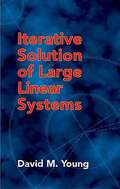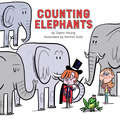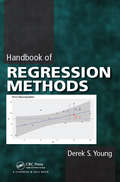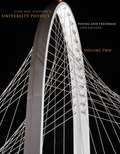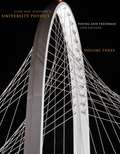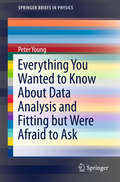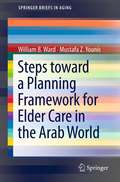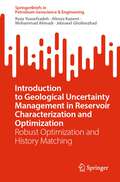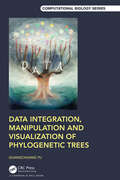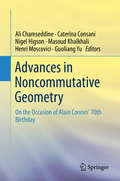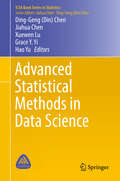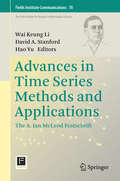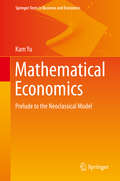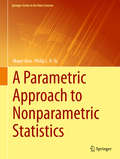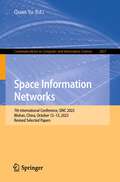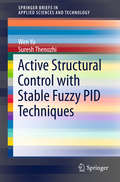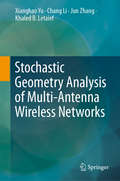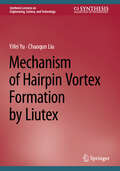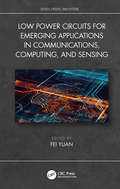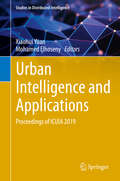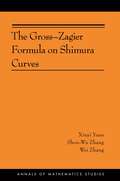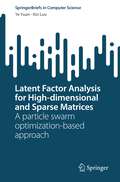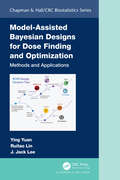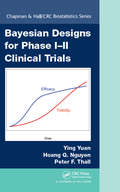- Table View
- List View
Iterative Solution of Large Linear Systems
by David M. YoungThis self-contained treatment offers a systematic development of the theory of iterative methods. Its focal point resides in an analysis of the convergence properties of the successive overrelaxation (SOR) method, as applied to a linear system with a consistently ordered matrix. The text explores the convergence properties of the SOR method and related techniques in terms of the spectral radii of the associated matrices as well as in terms of certain matrix norms. Contents include a review of matrix theory and general properties of iterative methods; SOR method and stationary modified SOR method for consistently ordered matrices; nonstationary methods; generalizations of SOR theory and variants of method; second-degree methods, alternating direction-implicit methods, and a comparison of methods. 1971 edition.
Counting Elephants
by Dawn YoungMath + Magic = chaos. A zany book about counting elephants before they disappear! Our poor counter just wants to count her ten elephants, but - POOF! - her magician friend is making it impossible. Ten, nine, eight... each time we get back to counting, one of the elephants has been changed into something unexpected. Puppies, frogs, peanut butter and jelly, and, of course, a rabbit and a hat appear and disappear in this funny, fast-paced story.
Handbook of Regression Methods
by Derek Scott YoungHandbook of Regression Methods concisely covers numerous traditional, contemporary, and nonstandard regression methods. The handbook provides a broad overview of regression models, diagnostic procedures, and inference procedures, with emphasis on how these methods are applied. The organization of the handbook benefits both practitioners and researchers, who seek either to obtain a quick understanding of regression methods for specialized problems or to expand their own breadth of knowledge of regression topics. This handbook covers classic material about simple linear regression and multiple linear regression, including assumptions, effective visualizations, and inference procedures. It presents an overview of advanced diagnostic tests, remedial strategies, and model selection procedures. Finally, many chapters are devoted to a diverse range of topics, including censored regression, nonlinear regression, generalized linear models, and semiparametric regression. Features Presents a concise overview of a wide range of regression topics not usually covered in a single text Includes over 80 examples using nearly 70 real datasets, with results obtained using R Offers a Shiny app containing all examples, thus allowing access to the source code and the ability to interact with the analyses
Statistical Treatment of Experimental Data
by Hugh D. YoungDealing with statistical treatment of experimental data, this text covers topics such as errors, probability, the binomial distribution, the Poisson distribution, the Gauss distribution, method of least squares and standard deviation of the mean.
Sears and Zemansky's: University Physics, Volume 2
by Hugh D. Young Roger A. Freedman A. Lewis FordUniversity Physics Volume 2 (Chapers 21-37), 13/e continues to set the benchmark for clarity and rigor combined with effective teaching and research-based innovation. University Physics is known for its uniquely broad, deep, and thoughtful set of worked examples-key tools for developing both physical understanding and problem-solving skills. The Thirteenth Edition revises all the Examples and Problem-Solving Strategies to be more concise and direct while maintaining the Twelfth Edition's consistent, structured approach and strong focus on modeling as well as math. To help students tackle challenging as well as routine problems, the Thirteenth Edition adds Bridging Problems to each chapter, which pose a difficult, multiconcept problem and provide a skeleton solution guide in the form of questions and hints. The text's rich problem sets-developed and refined over six decades-are upgraded to include larger numbers of problems that are biomedically oriented or require calculus. The problem-set revision is driven by detailed student-performance data gathered nationally through MasteringPhysics®, making it possible to fine-tune the reliability, effectiveness, and difficulty of individual problems.
University Physics: Volume 3
by Hugh D. Young Roger A. Freedman A. Lewis FordUniversity Physics Volume 3 (Chapters 37-44 only), 13/e continues to set the benchmark for clarity and rigor combined with effective teaching and research-based innovation. University Physics is known for its uniquely broad, deep, and thoughtful set of worked examples--key tools for developing both physical understanding and problem-solving skills. The Thirteenth Edition revises all the Examples and Problem-Solving Strategies to be more concise and direct while maintaining the Twelfth Edition's consistent, structured approach and strong focus on modeling as well as math. To help students tackle challenging as well as routine problems, the Thirteenth Edition adds Bridging Problems to each chapter, which pose a difficult, multiconcept problem and provide a skeleton solution guide in the form of questions and hints. The text's rich problem sets--developed and refined over six decades--are upgraded to include larger numbers of problems that are biomedically oriented or require calculus.
Everything You Wanted to Know About Data Analysis and Fitting but Were Afraid to Ask
by Peter YoungThese notes describe how to average and fit numerical data that have been obtained either by simulation or measurement. Following an introduction on how to estimate various average values, they discuss how to determine error bars on those estimates, and how to proceed for combinations of measured values. Techniques for fitting data to a given set of models will be described in the second part of these notes. This primer equips readers to properly derive the results covered, presenting the content in a style suitable for a physics audience. It also includes scripts in python, perl and gnuplot for performing a number of tasks in data analysis and fitting, thereby providing readers with a useful reference guide.
Steps Toward a Planning Framework for Elder Care in the Arab World
by Mustafa Z. Younis William B. WardThis book reviews the elder care literature pertaining to the Arab world and proposes steps that can be taken to improve the health and quality of life of older people in this region. Organized in three main sections (Program Assessment, Program Planning, Conclusions and Recommendations), the book addresses such topics as developing a conceptual framework; Arab world elder demographics; quality of life issues; demand for services; training issues; training capacity and capabilities; and conclusions and recommendations for improving the health of older persons in the Arab world. While the countries of the Arab world have the advantage of a unified language and culture that can be used to expedite development of area-wide approaches to a system of elder care, the lack of economic and political unification (such as common market and open trade) along with institutionalized age discrimination (some Arab countries restrict hiring for government and private jobs to persons younger than 45) present barriers to improving the health of older people. In addition, modernization and ease of transportation have resulted in a heavy focus on Western-style fast food, with an accompanying increase in chronic diseases such as hypertension, cardiovascular disease, diabetes, and cancer.
Introduction to Geological Uncertainty Management in Reservoir Characterization and Optimization: Robust Optimization and History Matching (SpringerBriefs in Petroleum Geoscience & Engineering)
by Reza Yousefzadeh Alireza Kazemi Mohammad Ahmadi Jebraeel GholinezhadThis book explores methods for managing uncertainty in reservoir characterization and optimization. It covers the fundamentals, challenges, and solutions to tackle the challenges made by geological uncertainty. The first chapter discusses types and sources of uncertainty and the challenges in different phases of reservoir management, along with general methods to manage it. The second chapter focuses on geological uncertainty, explaining its impact on field development and methods to handle it using prior information, seismic and petrophysical data, and geological parametrization. The third chapter deals with reducing geological uncertainty through history matching and the various methods used, including closed-loop management, ensemble assimilation, and stochastic optimization. The fourth chapter presents dimensionality reduction methods to tackle high-dimensional geological realizations. The fifth chapter covers field development optimization using robust optimization, including solutions for its challenges such as high computational cost and risk attitudes. The final chapter introduces different types of proxy models in history matching and robust optimization, discussing their pros and cons, and applications. The book will be of interest to researchers and professors, geologists and professionals in oil and gas production and exploration.
Data Integration, Manipulation and Visualization of Phylogenetic Trees (Chapman & Hall/CRC Computational Biology Series)
by Guangchuang YuData Integration, Manipulation and Visualization of Phylogenetic Trees introduces and demonstrates data integration, manipulation and visualization of phylogenetic trees using a suite of R packages, tidytree, treeio, ggtree and ggtreeExtra. Using the most comprehensive packages for phylogenetic data integration and visualization, contains numerous examples that can be used for teaching and learning. Ideal for undergraduate readers and researchers with a working knowledge of R and ggplot2. Key Features: Manipulating phylogenetic tree with associated data using tidy verbs Integrating phylogenetic data from diverse sources Visualizing phylogenetic data using grammar of graphics
Advances in Noncommutative Geometry: On the Occasion of Alain Connes' 70th Birthday
by Guoliang Yu Ali Chamseddine Caterina Consani Nigel Higson Masoud Khalkhali Henri MoscoviciThis authoritative volume in honor of Alain Connes, the foremost architect of Noncommutative Geometry, presents the state-of-the art in the subject. The book features an amalgam of invited survey and research papers that will no doubt be accessed, read, and referred to, for several decades to come. The pertinence and potency of new concepts and methods are concretely illustrated in each contribution. Much of the content is a direct outgrowth of the Noncommutative Geometry conference, held March 23–April 7, 2017, in Shanghai, China. The conference covered the latest research and future areas of potential exploration surrounding topology and physics, number theory, as well as index theory and its ramifications in geometry.
Advanced Statistical Methods in Data Science (ICSA Book Series in Statistics)
by Hao Yu Ding-Geng Chen Jiahua Chen Xuewen Lu Grace Y. YiThis book gathers invited presentations from the 2nd Symposium of the ICSA- CANADA Chapter held at the University of Calgary from August 4-6, 2015. The aim of this Symposium was to promote advanced statistical methods in big-data sciences and to allow researchers to exchange ideas on statistics and data science and to embraces the challenges and opportunities of statistics and data science in the modern world. It addresses diverse themes in advanced statistical analysis in big-data sciences, including methods for administrative data analysis, survival data analysis, missing data analysis, high-dimensional and genetic data analysis, longitudinal and functional data analysis, the design and analysis of studies with response-dependent and multi-phase designs, time series and robust statistics, statistical inference based on likelihood, empirical likelihood and estimating functions. The editorial group selected 14 high-quality presentations from this successful symposium and invited the presenters to prepare a full chapter for this book in order to disseminate the findings and promote further research collaborations in this area. This timely book offers new methods that impact advanced statistical model development in big-data sciences.
Advances in Time Series Methods and Applications: The A. Ian McLeod Festschrift (Fields Institute Communications #78)
by Hao Yu Wai Keung Li David A. StanfordThis volume reviews and summarizes some of A. I. McLeod's significant contributions to time series analysis. It also contains original contributions to the field and to related areas by participants of the festschrift held in June 2014 and friends of Dr. McLeod. Covering a diverse range of state-of-the-art topics, this volume well balances applied and theoretical research across fourteen contributions by experts in the field. It will be of interest to researchers and practitioners in time series, econometricians, and graduate students in time series or econometrics, as well as environmental statisticians, data scientists, statisticians interested in graphical models, and researchers in quantitative risk management.
Mathematical Economics: Prelude to the Neoclassical Model (Springer Texts in Business and Economics)
by Kam YuThis textbook provides a one-semester introduction to mathematical economics for first year graduate and senior undergraduate students. Intended to fill the gap between typical liberal arts curriculum and the rigorous mathematical modeling of graduate study in economics, this text provides a concise introduction to the mathematics needed for core microeconomics, macroeconomics, and econometrics courses. Chapters 1 through 5 builds students’ skills in formal proof, axiomatic treatment of linear algebra, and elementary vector differentiation. Chapters 6 and 7 present the basic tools needed for microeconomic analysis. Chapter 8 provides a quick introduction to (or review of) probability theory. Chapter 9 introduces dynamic modeling, applicable in advanced macroeconomics courses. The materials assume prerequisites in undergraduate calculus and linear algebra. Each chapter includes in-text exercises and a solutions manual, making this text ideal for self-study.
A Parametric Approach to Nonparametric Statistics (Springer Series in the Data Sciences)
by Philip L. H. Yu Mayer AlvoThis book demonstrates that nonparametric statistics can be taught from a parametric point of view. As a result, one can exploit various parametric tools such as the use of the likelihood function, penalized likelihood and score functions to not only derive well-known tests but to also go beyond and make use of Bayesian methods to analyze ranking data. The book bridges the gap between parametric and nonparametric statistics and presents the best practices of the former while enjoying the robustness properties of the latter. This book can be used in a graduate course in nonparametrics, with parts being accessible to senior undergraduates. In addition, the book will be of wide interest to statisticians and researchers in applied fields.
Space Information Networks: 7th International Conference, SINC 2023, Wuhan, China, October 12–13, 2023, Revised Selected Papers (Communications in Computer and Information Science #2057)
by Quan YuThis book constitutes revised selected papers from the thoroughly refereed proceedings of the 7th International Conference on Space Information Network, SINC 2023, held in Wuhan, China, during October 12–13, 2023. The 8 full papers and 5 short papers included in this book were carefully reviewed and selected from 73 submissions. The papers present the latest research in the fields of space information networks.
Active Structural Control with Stable Fuzzy PID Techniques (SpringerBriefs in Applied Sciences and Technology)
by Wen Yu Suresh ThenozhiThis book presents a detailed discussion of intelligenttechniques to measure the displacement of buildings when they are subjected tovibration. It shows how these techniques are used to control active devicesthat can reduce vibration 60-80% more effectively than widely used passiveanti-seismic systems. After introducing various structural control devices andbuilding-modeling and active structural control methods, the authors proposeoffset cancellation and high-pass filtering techniques to solve some commonproblems of building-displacement measurement using accelerometers. The mostpopular control algorithms in industrial settings, PD/PID controllers, are thenanalyzed and then combined with fuzzy compensation. The stability of thiscombination is proven with standard weight-training algorithms. These conditionsprovide explicit methods for selecting PD/PID controllers. Finally, fuzzy-logicand sliding-mode control are applied to the control of wind-induced vibration. The methods described are supported by reports of experimental studies on atwo-story building prototype. This book is avaluable resource for academic researchers interested in the effects of controland mechatronic devices within buildings, or those studying the principles ofvibration reduction. Practicing engineers working on the design andconstruction of any sort of high-rise or vulnerable building and concerned withthe effects of either wind or seismic disturbances benefit from the efficacy ofthe methods proposed.
Stochastic Geometry Analysis of Multi-Antenna Wireless Networks
by Xianghao Yu Chang Li Jun Zhang Khaled B. LetaiefThis book presents a unified framework for the tractable analysis of large-scale, multi-antenna wireless networks using stochastic geometry. This mathematical analysis is essential for assessing and understanding the performance of complicated multi-antenna networks, which are one of the foundations of 5G and beyond networks to meet the ever-increasing demands for network capacity. Describing the salient properties of the framework, which makes the analysis of multi-antenna networks comparable to that of their single-antenna counterparts, the book discusses effective design approaches that do not require complex system-level simulations. It also includes various application examples with different multi-antenna network models to illustrate the framework’s effectiveness.
Mechanism of Hairpin Vortex Formation by Liutex (Synthesis Lectures on Engineering, Science, and Technology)
by Yifei Yu Chaoqun LiuThis book presents the importance of the mechanism of hairpin vortex formation to understanding flow transition, turbulence, and flow control. This book blends direct numerical simulation (DNS) and mathematical analysis with experiments to create a foundation for understanding turbulence. The authors discuss hairpin vortex as a main component of transitional flow and turbulent flow. In addition, Liutex is utilized and described as a theoretical system that presents valid tools for turbulence research. Readers are exposed to understanding 3D and non-linear instability; the Lambda vortex formation; sweeps, ejections, and shear instability; the Kelvin-Helmholtz instability and vortex ring formation; and turbulence generation and sustenance.
Low Power Circuits for Emerging Applications in Communications, Computing, and Sensing (Devices, Circuits, and Systems)
by Fei YuanThe book addresses the need to investigate new approaches to lower energy requirement in multiple application areas and serves as a guide into emerging circuit technologies. It explores revolutionary device concepts, sensors, and associated circuits and architectures that will greatly extend the practical engineering limits of energy-efficient computation. The book responds to the need to develop disruptive new system architecutres, circuit microarchitectures, and attendant device and interconnect technology aimed at achieving the highest level of computational energy efficiency for general purpose computing systems. <p><p>Features <li>Discusses unique technologies and material only available in specialized journal and conferences <li>Covers emerging applications areas, such as ultra low power communications, emerging bio-electronics, and operation in extreme environments <li>Explores broad circuit operation, ex. analog, RF, memory, and digital circuits <li>Contains practical applications in the engineering field, as well as graduate studies <li>Written by international experts from both academia and industry
Urban Intelligence and Applications: Proceedings of ICUIA 2019 (Studies in Distributed Intelligence)
by Xiaohui Yuan Mohamed ElhosenyThis volume presents selected papers from the International Conference on Urban Intelligence and Applications (ICUIA), which took place on May 10-12, 2019 in Wuhan, China. The goal of the conference was to bring together researchers, industry leaders, policy makers, and administrators to discuss emerging technologies and their applications to advance the design and implementation of intelligent utilization and management of urban assets, and thus contributing to the autonomous, reliable, and efficient operation of modern, smart cities. The papers are collated to address major themes of urban sustainability, urban infrastructure and management, smart city applications, image and signal processing, natural language processing, and machine learning for monitoring and communications applications. The book will be of interest to researchers and industrial practitioners working on geospatial theories and tools, smart city applications, urban mobility and transportation, and community well-being and management.
The Gross-Zagier Formula on Shimura Curves: (AMS-184) (Annals of Mathematics Studies #184)
by Xinyi Yuan Shou-wu Zhang Wei ZhangThis comprehensive account of the Gross-Zagier formula on Shimura curves over totally real fields relates the heights of Heegner points on abelian varieties to the derivatives of L-series. The formula will have new applications for the Birch and Swinnerton-Dyer conjecture and Diophantine equations. The book begins with a conceptual formulation of the Gross-Zagier formula in terms of incoherent quaternion algebras and incoherent automorphic representations with rational coefficients attached naturally to abelian varieties parametrized by Shimura curves. This is followed by a complete proof of its coherent analogue: the Waldspurger formula, which relates the periods of integrals and the special values of L-series by means of Weil representations. The Gross-Zagier formula is then reformulated in terms of incoherent Weil representations and Kudla's generating series. Using Arakelov theory and the modularity of Kudla's generating series, the proof of the Gross-Zagier formula is reduced to local formulas. The Gross-Zagier Formula on Shimura Curves will be of great use to students wishing to enter this area and to those already working in it.
Latent Factor Analysis for High-dimensional and Sparse Matrices: A particle swarm optimization-based approach (SpringerBriefs in Computer Science)
by Ye Yuan Xin LuoLatent factor analysis models are an effective type of machine learning model for addressing high-dimensional and sparse matrices, which are encountered in many big-data-related industrial applications. The performance of a latent factor analysis model relies heavily on appropriate hyper-parameters. However, most hyper-parameters are data-dependent, and using grid-search to tune these hyper-parameters is truly laborious and expensive in computational terms. Hence, how to achieve efficient hyper-parameter adaptation for latent factor analysis models has become a significant question.This is the first book to focus on how particle swarm optimization can be incorporated into latent factor analysis for efficient hyper-parameter adaptation, an approach that offers high scalability in real-world industrial applications. The book will help students, researchers and engineers fully understand the basic methodologies of hyper-parameter adaptation via particle swarm optimization in latent factor analysis models. Further, it will enable them to conduct extensive research and experiments on the real-world applications of the content discussed.
Model-Assisted Bayesian Designs for Dose Finding and Optimization: Methods and Applications (Chapman & Hall/CRC Biostatistics Series)
by Ying Yuan Ruitao Lin J. Jack LeeBayesian adaptive designs provide a critical approach to improve the efficiency and success of drug development that has been embraced by the US Food and Drug Administration (FDA). This is particularly important for early phase trials as they form the basis for the development and success of subsequent phase II and III trials. The objective of this book is to describe the state-of-the-art model-assisted designs to facilitate and accelerate the use of novel adaptive designs for early phase clinical trials. Model-assisted designs possess avant-garde features where superiority meets simplicity. Model-assisted designs enjoy exceptional performance comparable to more complicated model-based adaptive designs, yet their decision rules often can be pre-tabulated and included in the protocol—making implementation as simple as conventional algorithm-based designs. An example is the Bayesian optimal interval (BOIN) design, the first dose-finding design to receive the fit-for-purpose designation from the FDA. This designation underscores the regulatory agency's support of the use of the novel adaptive design to improve drug development. Features Represents the first book to provide comprehensive coverage of model-assisted designs for various types of dose-finding and optimization clinical trials Describes the up-to-date theory and practice for model-assisted designs Presents many practical challenges, issues, and solutions arising from early-phase clinical trials Illustrates with many real trial applications Offers numerous tips and guidance on designing dose finding and optimization trials Provides step-by-step illustrations of using software to design trials Develops a companion website (www.trialdesign.org) to provide freely available, easy-to-use software to assist learning and implementing model-assisted designs Written by internationally recognized research leaders who pioneered model-assisted designs from the University of Texas MD Anderson Cancer Center, this book shows how model-assisted designs can greatly improve the efficiency and simplify the design, conduct, and optimization of early-phase dose-finding trials. It should therefore be a very useful practical reference for biostatisticians, clinicians working in clinical trials, and drug regulatory professionals, as well as graduate students of biostatistics. Novel model-assisted designs showcase the new KISS principle: Keep it simple and smart!
Bayesian Designs for Phase I-II Clinical Trials (Chapman & Hall/CRC Biostatistics Series #92)
by Ying Yuan Hoang Q. Nguyen Peter F. ThallReliably optimizing a new treatment in humans is a critical first step in clinical evaluation since choosing a suboptimal dose or schedule may lead to failure in later trials. At the same time, if promising preclinical results do not translate into a real treatment advance, it is important to determine this quickly and terminate the clinical evaluation process to avoid wasting resources. Bayesian Designs for Phase I–II Clinical Trials describes how phase I–II designs can serve as a bridge or protective barrier between preclinical studies and large confirmatory clinical trials. It illustrates many of the severe drawbacks with conventional methods used for early-phase clinical trials and presents numerous Bayesian designs for human clinical trials of new experimental treatment regimes.Written by research leaders from the University of Texas MD Anderson Cancer Center, this book shows how Bayesian designs for early-phase clinical trials can explore, refine, and optimize new experimental treatments. It emphasizes the importance of basing decisions on both efficacy and toxicity.
